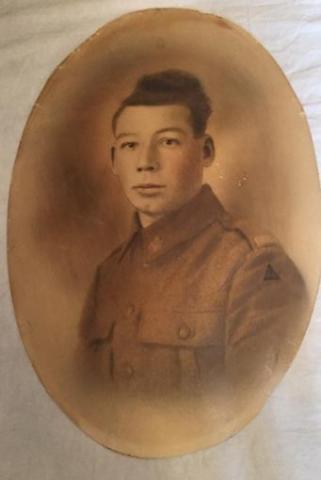
An unmarked grave
For 85 years—in Saint Columba’s Cemetery in Pembroke, Ontario—the remains of First World War Algonquin Veteran, Private Joseph Gagnon, lay buried in an unmarked grave.
“He should have been buried more ceremoniously,” said his great-granddaughter, Dr. Lynn Gehl, of Golden Lake Reserve, now Pikwàkanagàn First Nation in Ontario.
“It is very sad, the way Algonquin Veterans were treated. People deserve dignity in death.”
Righting the wrongs
As a way of righting some of the wrongs her great-grandfather faced in his life, Gehl took on the task of researching his history, his service and getting him a proper grave marker “so his descendants have a place to go and honour him.”
According to Gagnon’s attestation papers, he enlisted with the Canadian Expeditionary Force 12 May 1916, becoming a Private of the 207th (Ottawa-Carleton) Battalion. He left the port of Halifax 28 May 1917 on the Titanic sister ship RMS Olympic, arriving in Liverpool, England a month later.
By the following January, he was on a French battlefield.
That fall, he was shot in his right arm and left leg, returning to Canada in December 1918 on the injured list. He was discharged from the military on 24 January 1919.
Gagnon was married to Ann (Annie) Jane Meness. Both were members of the Pikwàkanagàn First Nation. They had five children, one of whom was Gehl’s grandmother, Viola.
Joseph Gagnon died in 1939 at age 51.

Lynn Gehl stands with her Great-Grandfather, Joseph Gagnon’s headstone.
Facing racism
She says her great-grandfather faced layers of racism and discrimination under the Indian Act and the way Indigenous Veterans were treated.
Like many First Nation Veterans, he was stripped of Indian status when he returned from war.
In her research, Gehl learned that Gagnon most likely did not receive any soldier benefits, including a Veteran’s pension.
“This situation is a horrible way to treat a Veteran,” Gehl wrote in a yet-to-be published article about her great-grandfather.
“Indigenous Veterans had to deal with double-racism: first, they were removed from their home communities; and second, they were marginalized in white settler society.”
Restoring honour
Based on his military records, Gagnon would have been entitled to the British War Medal and the Victory Medal, but the medal card is missing from his attestation papers meaning family members aren’t able to confirm if he ever received them.
Gehl worked with the Last Post Fund to install a grave marker, but patchy church records made it impossible to know the exact spot of his burial.
Relying on Anishinaabe knowledge, Gagnon’s grave marker is engraved with the encircled circle, the Indigenous symbol for creation, and the words “Buried elsewhere in this cemetery is Joseph Gagnon.”

Joseph Gagnon’s children in 1965.
Left to right; Kenneth, Viola, Gordon, Cecelia and Steve.
Family connection
Gehl said the process of researching his life, service and final resting place helped her develop “an embodied, heartfelt relationship” with a relative she never met.
“He went from a person I didn’t know to someone I felt I knew better,” she said.
And the process helped her in a personal quest to help right historic wrongs that Indigenous Canadians have faced.
Today, Gehl is the author of four books and holds a doctorate in Indigenous Studies, a Master’s in Canadian Studies and Native Studies, a Bachelor’s in Cultural Anthropology and a community college diploma in Chemical Technology. During her graduate studies, she was both an Ontario Graduate Scholar and a Social Sciences and Humanities Research Council of Canada Fellow.
Gehl was finally registered as a status Indian and became a member of Pikwàkanagàn First Nation in 2017.
Joseph Gagnon’s story lives on in the hearts of his family, his province and the people of Pikwàkanagàn First Nation. Together, they are making sure he is never forgotten.